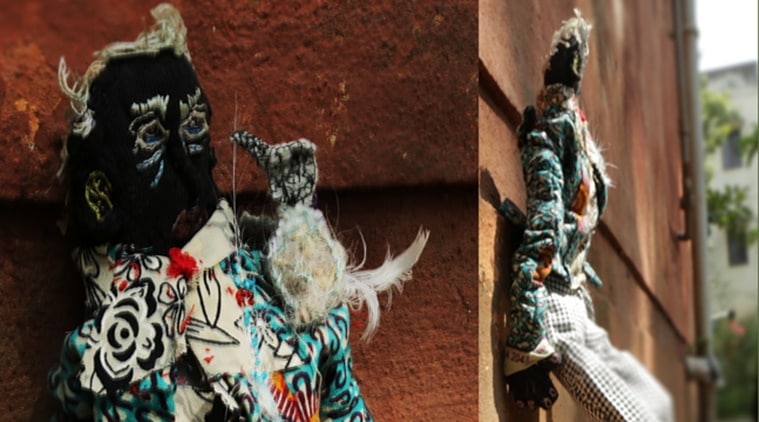 Hansa Thapliyal conducts doll-making workshops. (Source: Hansa Thapliyal)
Hansa Thapliyal conducts doll-making workshops. (Source: Hansa Thapliyal)
A few years ago, in the middle of the night, Bengaluru-based filmmaker Hansa Thapliyal realised it was her friend’s birthday the next day and decided to make a doll for her. In the kitchen, were some tissue papers and, on her worktable, bottles of red and blue inks. “I mixed the inks to a purple shade and dipped the tissue into it. Soaked in ink and crumpled, the tissue became the body,” she says. Next, Thapliyal found a little piece of wire, which wound with thread, became a face. “I discovered a bit of gota from the edge of a dupatta and made a crown. My friend wears a nose pin, so I put a nose pin for the doll and she started becoming her own person,” says Thapliyal. With white thread, she made four or five thin braids for the doll. “I gave the doll a little pair of eyes, looked at it, and said, ‘You are Bhooti Devi,’” she says.
On May 17 and 18, 3 pm-6pm, Thapliyal will conduct a doll-making workshop where it would “be fine to create weird things”. Traditionally, dolls have been charming playthings for children or finely crafted artefacts for collectors. A slew of films have popularised the scary doll. Thapliyal’s dolls, however, defy the conventions. “”We have tyrannical ideas of beauty. I don’t find my dolls looking weird but I can understand somebody else might,” she says.
 Rose-skinned doll. (Source: Hansa Thapliyal)
Rose-skinned doll. (Source: Hansa Thapliyal)
In the crowded world of documentary filmmaking, Thapliyal, who graduated from FTII in 1998, is well-regarded for her work on the histories of technologies that predated cinema. The films she has made, The Outside In and Ghar Ek Studio, have been screened at IAWRT and Open Frame festivals in Delhi, among others. Another film, Cinema ka Sapna Dekha Hai, revolves around three women who live close to film city and their relationship to cinema. Thapliyal was also associate director in She Was Once a Queen, a film on the ideas of peace and justice and what these mean to women in Kashmir.
Dolls are her less-known passion. “I never understood my fascination with dolls, which is why I make them without asking too many questions about why I liked them. But, over time, making dolls has become something I can do without inhibitions. I may be more inhibited about my film work and think. ‘This is not good enough and that is not the correct way do it” but, with dolls, I have no prior ideas about what it should be or look like,” she says.
She uses the same creative instinct she did as a child, growing up in Lucknow, when she cut the golden hair from a ripened corn cob and used it to make blonde tassles for a doll. Her films The Outside In, produced by PSBT in Delhi, revolves around two women who make dolls, and Ghar Ek Studio that revolves around her family home features another doll she has made, whose skin is pink fabric with rose print. “I find that I carry the freedom of doll-making to my other work. I feel the sense of not getting scared of the chaos of things. There is something pleasurable in making things,” she says.
A participant begins with any material at her workshops, from a piece of plastic to paper. As the first step, they transform every piece of material. “You can take a pair of scissors to the material or stitch it or yank it. You need to just make your mark on the material. These are ways in which you come out of yourself,” she says. At Shristi in Bengaluru, her doll-making workshops extend to two weeks and involve sharing of material and memories. At the online workshop, which lasts three hours, there will be a break to talk to each other about different things, such as observations to about the present situation. “In the next phase, participants can look at anything that seems to suggest a form and start putting the things together to create a shape. They keep working on it till they are satisfied. It is my hunch that they will get their doll. Some little fellow will come out at the end of the workshop that participants will recognise for themselves and feel attached to,” she says. The dolls don’t have names but “their appearance gives them personalities”.